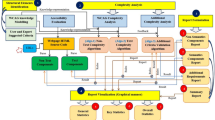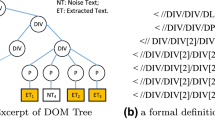Abstract
To identify recruitment information in different domains, we propose a novel model of hierarchical tree-structured conditional random fields (HT-CRFs). In our approach, first, the concept of a Web object (WOB) is discussed for the description of special Web information. Second, in contrast to traditional methods, the Boolean model and multi-rule are introduced to denote a one-dimensional text feature for a better representation of Web objects. Furthermore, a two-dimensional semantic texture feature is developed to discover the layout of a WOB, which can emphasize the structural attributes and the specific semantics term attributes of WOBs. Third, an optimal WOB information extraction (IE) based on HT-CRF is performed, addressing the problem of a model having an excessive dependence on the page structure and optimizing the efficiency of the model’s training. Finally, we compare the proposed model with existing decoupled approaches for WOB IE. The experimental results show that the accuracy rate of WOB IE is significantly improved and that time complexity is reduced.
Similar content being viewed by others
References
Cui H, Kan M Y, Chua T S. Soft pattern matching models for definitional question answering. ACM Transactions on Information Systems, 2007, 25(2)
Nyberg E, Mitamura T, Callan J, Carbonell J, et al. The JAVELIN question-answering system at TREC 2003: a multi-strategy approach with dynamic planning. In: Proceedings of the 12th Text Retrieval Conference. 2003
Mooney R J, Bunescu R. Mining knowledge from text using information extraction. ACM SIGKDD Explorations Newsletter, 2005, 7(1): 3–10
Kobayashi N, Iida R, Inui K, Matsumoto Y. Opinion mining on the web by extracting subject-attribute-value relations. In: Proceedings of AAAI-CAAW’06. 2006
Loth R, Battistelli D, Chaumartin F, et al. Linguistic information extraction for job ads. In: Proceedings of the 9th International Conference on Adaptivity Personalization and Fusion of Heterogeneous Information. 2010
Ye S, Chua T. Learning object models from semistructured web documents. IEEE Transactions on Knowledge and Data Engineering, 2006, 18(3): 334–349
Jinlin C, Ping Z, Cook T. Detecting web content function using generalized hidden Markov model. In: Proceedings of the IEEE 5th International Conference on Machine Learning and Applications. 2006, 279–284
Freitag D, McCallum A. Information extraction with HMM structures learned by stochastic optimization. In: Proceedings of American Association for Artificial Intelligence (AAAI-00). 2000, 584–589
Haileong C, Hweetou N. A maximum entropy approach to information extraction from semi-structured and free text. In: Proceedings of American Association for Artificial Intelligence (AAAI-02). 2002, 786–791
Finn A, Kushmerick N. A multi-level boundary classification approach to information extraction. In: Proceedings of the 15th European Conference on Machine Learning. 2004, 111–122
Zhu Z. Weakly-supervised relation classification for information extraction. In: Proceedings of the 13th ACM International Conference on Information and Knowledge Management. 2004, 581–588
Wallach H. Conditional random fields: an introduction. University of Pennsylvania CIS Technical Report MS-CIS-04-21. 2004
Kristjansson T, Culotta A, Viola P, McCallum A. Interactive information extraction with constrained conditional random fields. In: Proceedings of American Association for Artificial Intelligence (AAAI-04). 2004, 412–418
Lafferty J, Xiaojin Z, Yan L. Kernel conditional random fields: representation and clique selection. In: Proceedings of the 21st International Conference on Machine Learning (ICML-2004). 2004
Trevor C, Blunsom P. Semantic role labelling with tree conditional random fields. In: Proceedings of the 9th Conference on Computational Natural Language Learning (CoNLL). 2005, 169–172
Chen M M, Chen Y X, Brent M R, Tenney A E. Constrained optimization for validation-guided conditional random field learning. In: Proceedings of the 15th ACM SIGKDD international conference on Knowledge discovery and data mining. 2009, 189–198
Xiao J H, Wang X L, Liu B Q. The study of a nonstationary maximum entropy Markov model and its application on the pos-tagging task. In: Processings of ACM Transactions on Asian Language Information. 2007, 6(2)
Lafferty J, Mccallum A, Pereira F. Conditional random fields: probabilistic models for segmenting and labeling sequence data. In: Proceedings of the 18th International Conference on Machine Learning (ICML 2001). 2001, 282–289
Cohn T, Blunsom P. Semantic role labelling with tree conditional random fields. In: Proceedings of the 9th Conference on Computational Natural Language Learning (CoNLL). 2005, 169–172
Xu Z T. Hierarchical conditional random fields for Chinese part-of speech tagging. Midterm Report for National Undergraduate Innovational Experimental Program. 2007
Peng F C, Feng F F, McCallum A. Chinese segmentation and new word detection using conditional random fields. In: Proceedings of the 20th international conference on Computational Linguistics. 2004
Peng F C, McCallum A. Accurate information extraction from research papers using conditional random fields. In: Proceedings of the Human Language Technology Conference on the North American Chapter of the Association for Computational Linguistics (HLT-NAACL 2004). 2004, 329–336
Li W, McCallum A. Rapid development of Hindi named entity recognition using conditional random fields and feature induction. Journal ACM Transactions on Asian Language Information Processing (TALIP), 2003, 2(3): 290–294
Zhu J, Nie Z Q, Wen J R, Ma W Y. 2D conditional random fields for web information extraction. In: Proceedings of the 22nd International Conference on Machine Learning. 2005, 1044–1051
Tang J, Hong MC, Li J Z, Liang B. Tree-structured conditional random fields for semantic annotation. In: Proceedings of the 5th International Semantic Web Conference (ISWC 2006). 2006, 4273(5): 640–653
Zhu J, Zhang B, Nie Z Q, Wen J R, Hong H W. Webpage understanding: an integrated approach. In: Proceedings of the 13th ACM SIGKDD International Conference on Knowledge Discovery and Data Mining. 2007, 903–912
Truyen T T, Phung D Q, Bui H H, Venkatesh S. Hierarchical semimarkov conditional random fields for recursive sequential data. In: Proceedings of the 22nd Annual Conference on Neural Information Processing Systems. 2008
Zhu J. Nie Z Q, Zhang B, Wen J R. Dynamic hierarchical Markov random fields for integrated web data extraction. Journal of Machine Learning Research, 2008, 9: 1583–1614
Nie Z Q, Zhang Y Z, Wen J R, Ma W Y. Object-level ranking: bringing order to web objects. In: Proceedings of WWW Conference. 2005, 567–574
Yang X Y, Liu J. Maximum entropy random fields for texture analysis. Pattern Recognition Letters, 2002, 23(1): 93–101
Salton G, Wong A, Yang C S. A vector space model for automatic indexing. Communication of the ACM, 1975, 18(5): 613–620
Cai D, Yu S P, Wen J R, Ma W Y. VIPS: a visionbased page segmentation algorithm. Microsoft Technical Report, MSR-TR-2003-79, 2003
Author information
Authors and Affiliations
Corresponding author
Additional information
Jing Wang is a lecturer in the School of Computer Science and Technology, Xidian University, China. She Received her PhD, MS, and BS in Computer Science from Xidian University in 2011, 2008, and 2003, respectively. Her research interests are data mining and machine learning.
Zhijing Liu, is a professor and advisor for doctoral students. He graduated from the Department of Computer Engineering of Northwestern Telecommunications Engineering Institute in 1982. He currently serves as the head of the Research Center of Computer Information Research Application, and is the director of the China and America Associated Laboratory of key Technologies of Mobile Electronic Commerce. His research works focus on the fields of data mining and vision computing.
Hui Zhao is a PhD candidate at the School of Electronic and Information Engineering, Xi’an Jiaotong University. He Received his BS and MS from Xidian University in 2008. His research interests include data mining, information retrieval, and mobile learning.
Rights and permissions
About this article
Cite this article
Wang, J., Liu, Z. & Zhao, H. A probabilistic model with multi-dimensional features for object extraction. Front. Comput. Sci. 6, 513–526 (2012). https://doi.org/10.1007/s11704-012-1093-3
Received:
Accepted:
Published:
Issue Date:
DOI: https://doi.org/10.1007/s11704-012-1093-3




